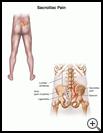
Sacroiliac Joint Pain
________________________________________________________________________
KEY POINTS
- Sacroiliac joint pain is discomfort or pain in a joint in your lower back or buttocks, below your waist.
- Treatment may include physical therapy, stretching and strengthening exercises, massage, chiropractic adjustment, and sometimes medicine.
- To help prevent sacroiliac joint pain, do warm-up exercises and stretching before activities, and try not to twist when you lift heavy objects.
________________________________________________________________________
What is sacroiliac joint pain?
Sacroiliac joint pain is discomfort or pain in a joint in your lower back or buttocks, below your waist. The sacroiliac joints are the joints between your lower backbone and your hip bones. Strong bands of tissue called ligaments hold the bones of the joints in place.
Pain in the sacroiliac joint is also called sacroiliac joint dysfunction.
What is the cause?
Some possible causes of sacroiliac joint pain are:
- Activities that involve twisting, bending, or heavy lifting, like swinging a golf club or shoveling snow
- Injury from a fall
- Imbalance of muscles because one leg is shorter than the other
- Poor posture
- Loosening of the ligaments after pregnancy
What are the symptoms?
Symptoms may include:
- Pain and stiffness in the buttocks, hips, or legs (pain may start in the back and travel to the legs)
- Trouble bending or twisting your lower back
- Pain after sitting for a long time
- A feeling of being "out of alignment"
How is it diagnosed?
Your healthcare provider will ask about your symptoms, activities, and medical history and examine you. You may have
- X-rays
- CT scan, which uses X-rays and a computer to show detailed pictures of the spinal cord and the tissues around it
- MRI, which uses a strong magnetic field and radio waves to show detailed pictures of the spinal cord and tissues around it
How is it treated?
Your healthcare provider may recommend stretching, exercises, or other types of physical therapy. Your provider, a physical therapist, or chiropractor may use massage or other techniques to help put the joint in better alignment.
Your provider may give 1 or more shots of numbing medicine and steroid medicine into the joint.
How can I take care of myself?
To help relieve swelling and pain:
- Put an ice pack, gel pack, or package of frozen vegetables wrapped in a cloth on the injured area every 3 to 4 hours for up to 20 minutes at a time.
- Take nonprescription pain medicine, such as acetaminophen, ibuprofen, or naproxen. Read the label and take as directed. Unless recommended by your healthcare provider, you should not take these medicines for more than 10 days.
- Nonsteroidal anti-inflammatory medicines (NSAIDs), such as ibuprofen, naproxen, and aspirin, may cause stomach bleeding and other problems. These risks increase with age.
- Acetaminophen may cause liver damage or other problems. Unless recommended by your provider, don't take more than 3000 milligrams (mg) in 24 hours. To make sure you don’t take too much, check other medicines you take to see if they also contain acetaminophen. Ask your provider if you need to avoid drinking alcohol while taking this medicine.
Use moist heat for up to 20 minutes at a time to help relax tight muscles or muscle spasms. Moist heat includes heat patches or moist heating pads that you can purchase at most drugstores, a wet washcloth or towel that has been heated in the dryer, or a hot shower. Don’t use heat if you have swelling.
If your legs are different lengths, special shoes or shoe inserts may help. Your healthcare provider may recommend a sacroiliac (SI) belt to help support the joint. An SI belt wraps around the hips just below the waist.
Follow your healthcare provider's instructions, including any exercises recommended by your provider. Ask your provider:
- How and when you will get your test results
- How long it will take to recover
- If there are activities you should avoid and when you can return to your normal activities
- How to take care of yourself at home
- What symptoms or problems you should watch for and what to do if you have them
Make sure you know when you should come back for a checkup.
How can I help prevent sacroiliac joint pain?
Here are some things you can do to help prevent sacroiliac joint pain:
- Do warm-up exercises and stretching before activities to help prevent injuries.
- Try not to twist when you lift heavy objects.
- Follow safety rules and use any protective equipment recommended for your work or sport.

